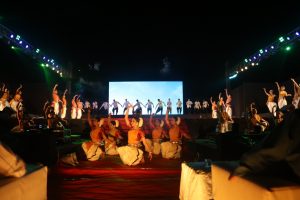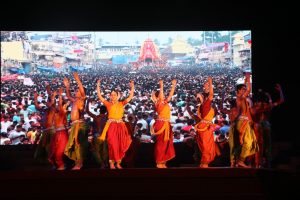When Classical Dance Becomes The Language Of History

How exactly you can deal with historical events in a dance production? After all, dance is all about the mystic and artistically nuanced expression of the human body. Can we really depict a century-stretched timeline of the sufferings and struggles of a state in a moving choreography? As a writer for Odissi dance choreography, I had to face such questions when something unusual came to my table to write about. Aruna Mohanty, the celebrated Odissi choreographer and dance Guru, wanted me to write for a dance production about the history of Srirama Chandra Bhanja (SCB) Medical College of Cuttack, the premier medical institute of Odisha. Of course, it’s not new in dance to sing about a personality or a historical event as dance drama. It’s highly unusual to talk about an institution in a choreographic form covering its social and scientific journey for more than a century. In a classical dance format, we needed to deal with a modern subject, which itself was a big challenge.
Centuries ago, SCB Medical College came into existence as a traditional Vaidyashala during the Maratha regime to treat the sick pilgrims heading to Puri. With the British regime, it grew as a medical school and became a medical college after the formation of the new Odisha state in 1936. The journey of SCB is in tandem with a series of disasters and devastations in Odisha. The healing touch of this medical institute continues to nurture humanity through tragedies like the ‘Na’Anka Durbhikshya’ or the Odisha famine of 1866 to the COVID-19 pandemic of the current time. In one sentence, the history of SCB is all about tragic challenges to mankind in Odisha and their determination to overcome the tragedies.


This kind of prosaic idea metamorphosed into poetic choreography through a well-crafted process of imagination and creativity by Aruna Mohanty. It was a highly unusual dance drama, blending classical and contemporary dance movements with audio-visual inputs, taking hundreds of dancers of various forms (Odissi, Gotipua and Contemporary) in its fold. It was not a traditional Odissi choreography, but a contemporary innovation and display of classical dance language. In this choreography, the tragic social history of Odisha was portrayed with subtle and smooth movements. One can shudder to see the falling human chain to show the disastrous famine of 1866. The movements are wavy, circular and enchantingly gorgeous. Interestingly, the dance presentation is not limited to the stage only, sometimes it goes out of the stage and involves the audience in its choreographic process. As an audience, you not only watch the show but are very much a part of the play. That’s a unique component of this artwork.


The production was named “Ashara Kirana” (the ray of hope) and literally, it created an aura of its own. It pushed up the boundary of Odissi dance a little further and created a space for novelty and creativity. The whole credit for this extraordinary choreography goes to Aruna Mohanty and her stunningly gorgeous and superbly disciplined group of Orissa Dance Academy dancers and musicians.

Comments are closed.